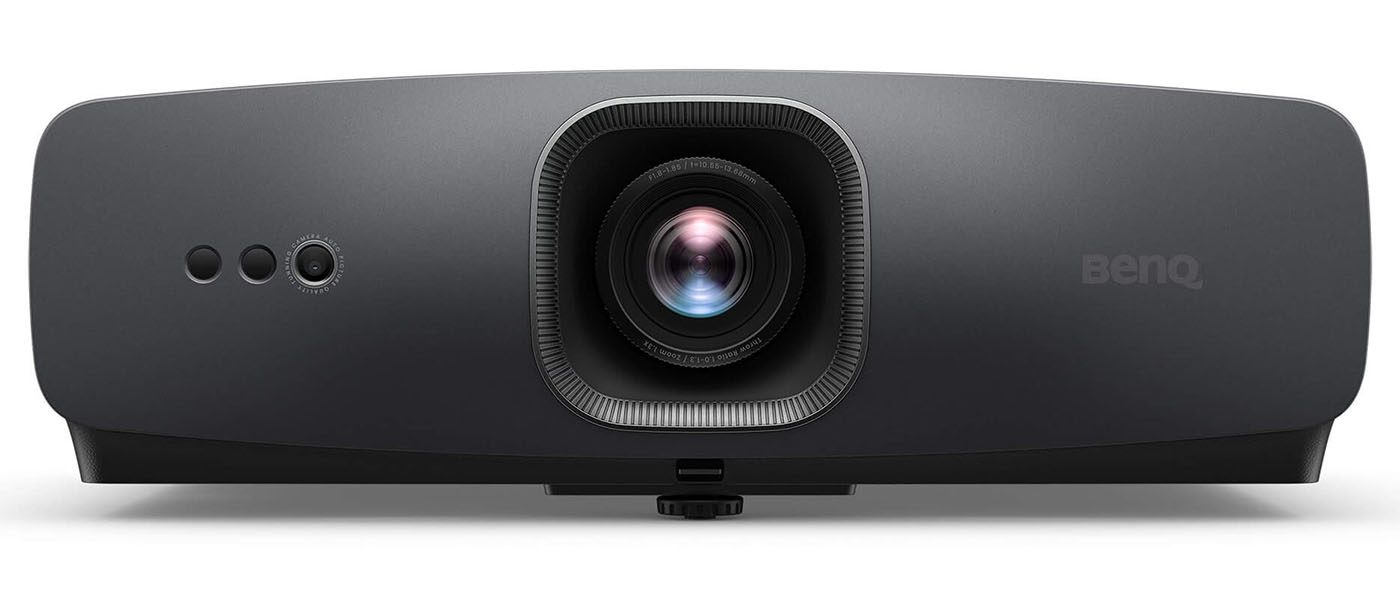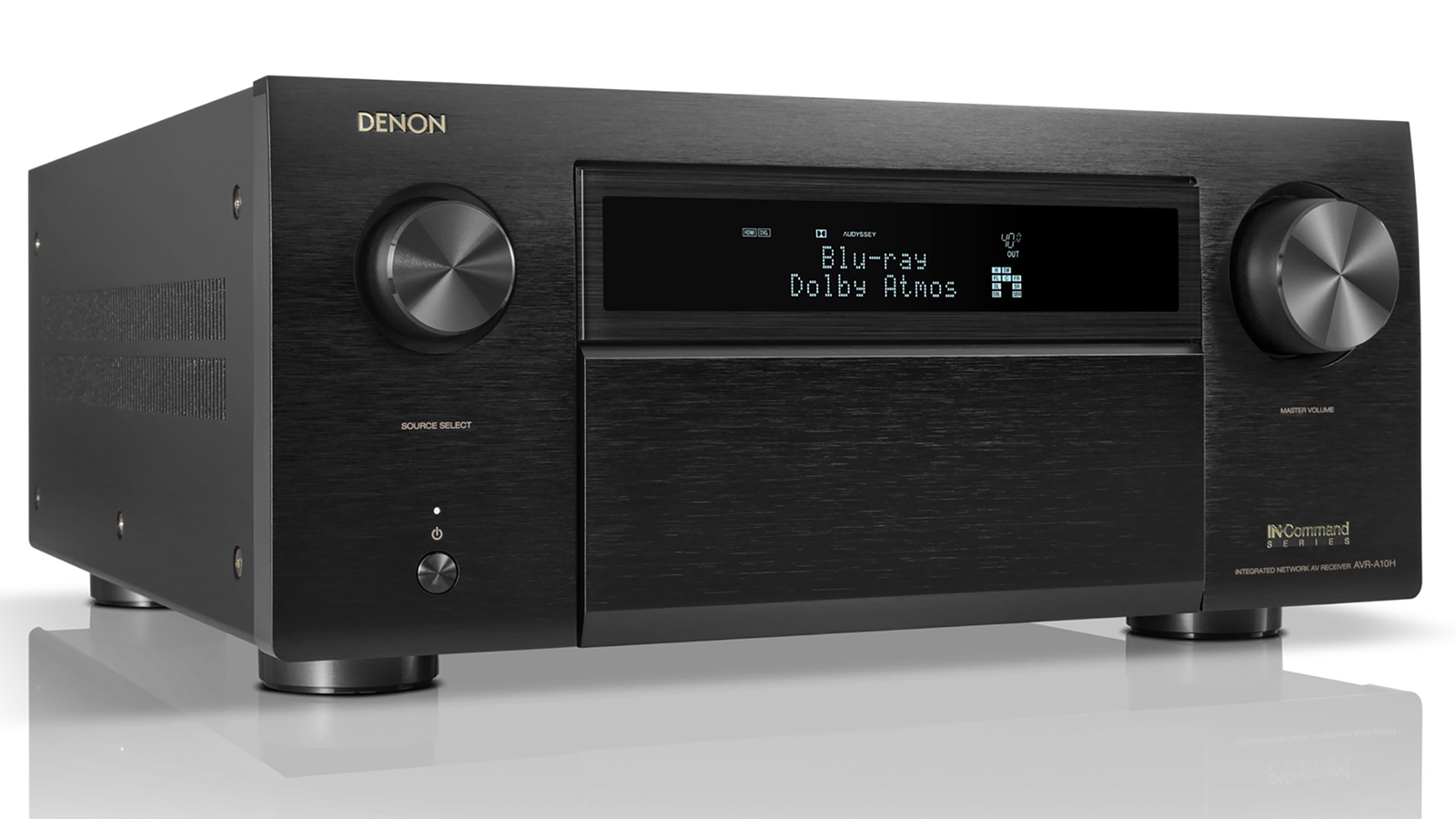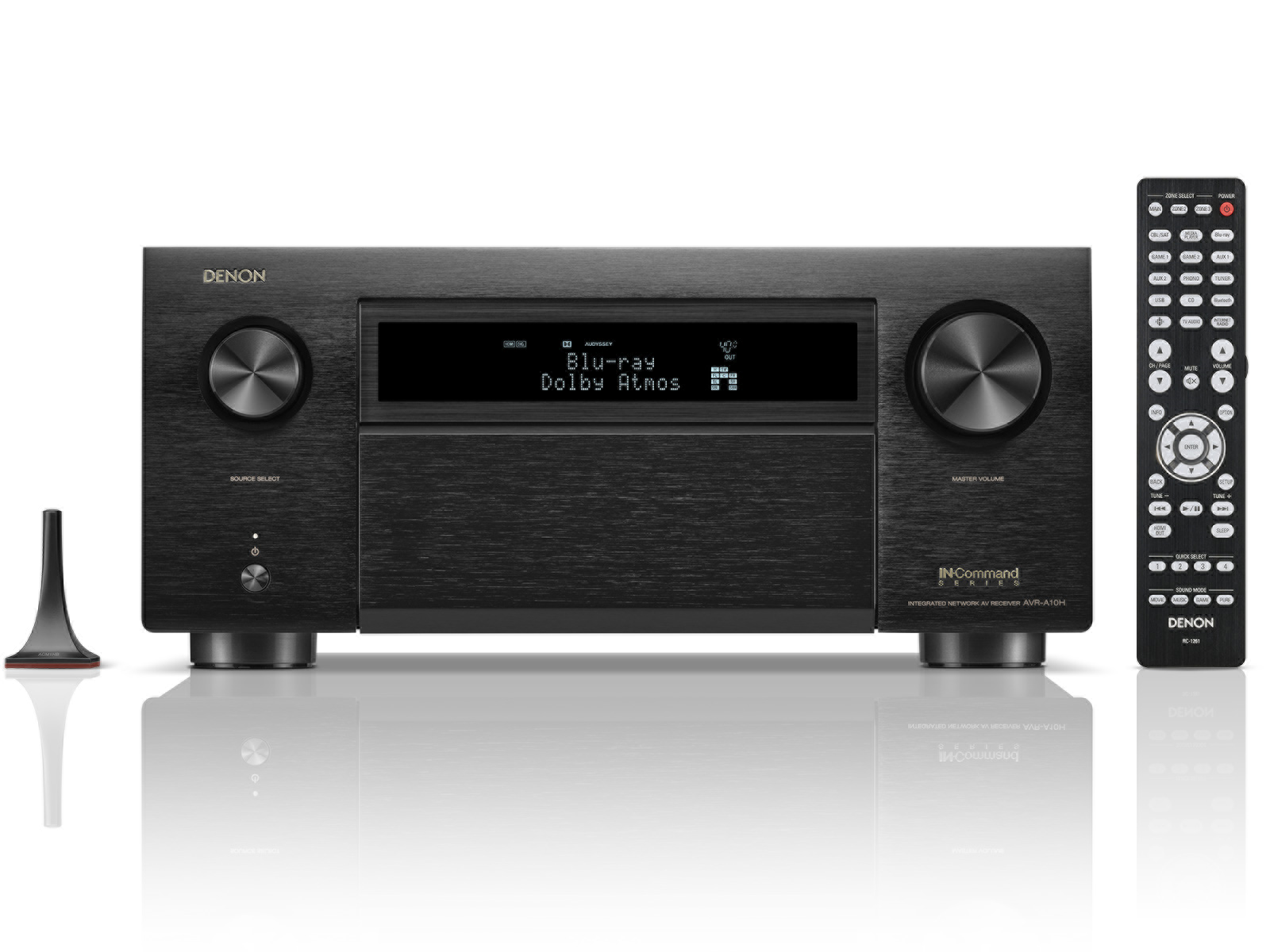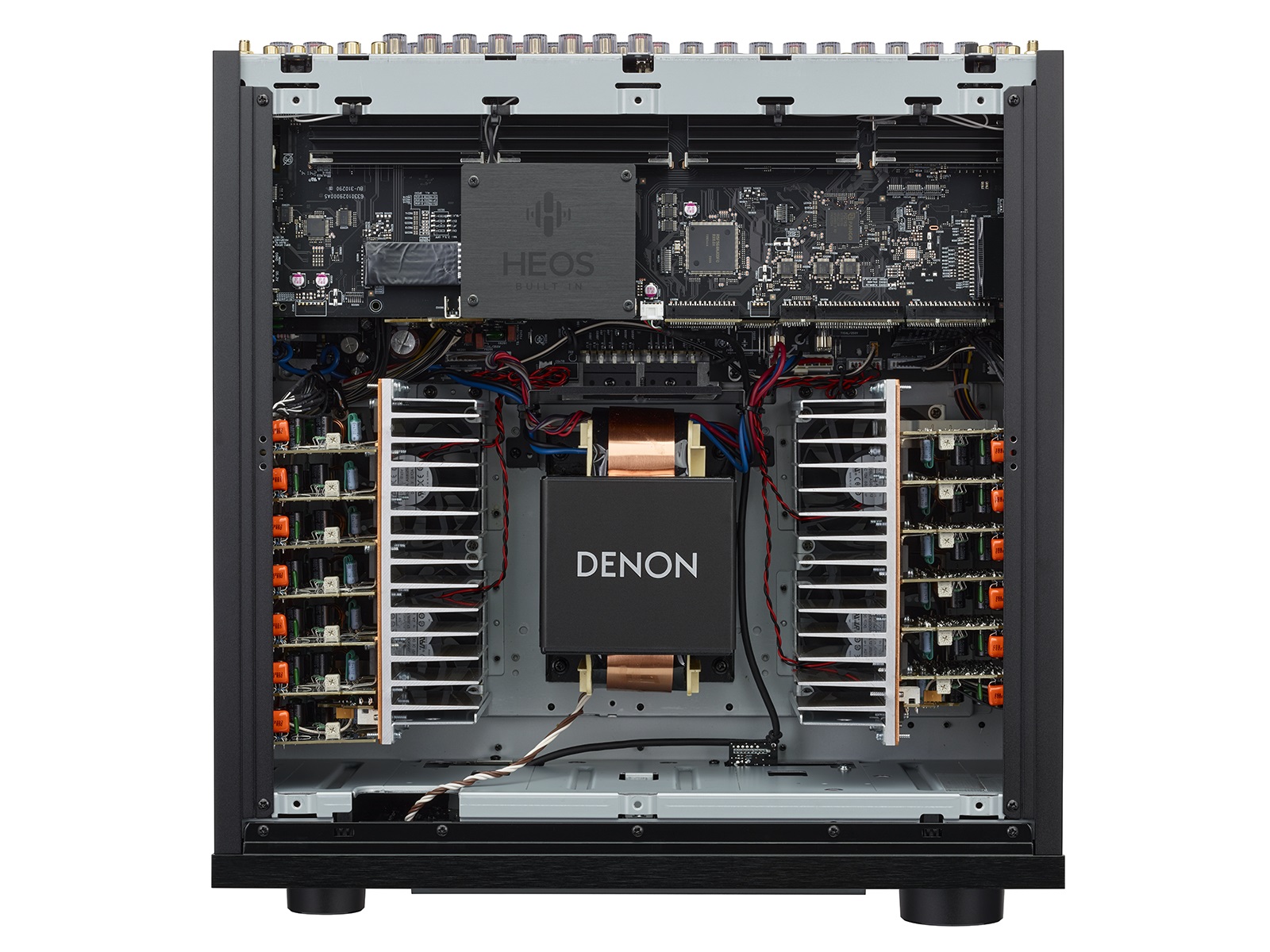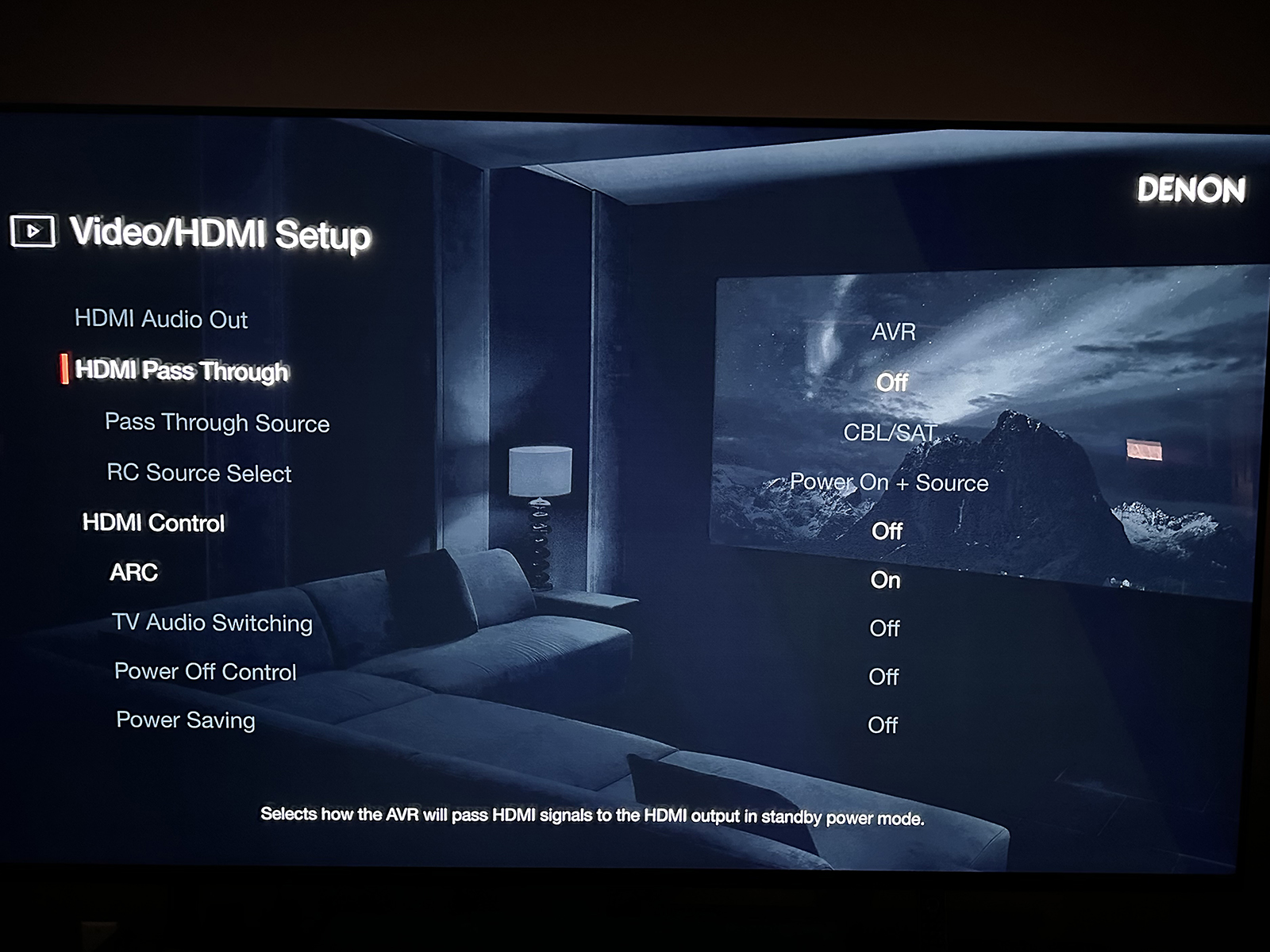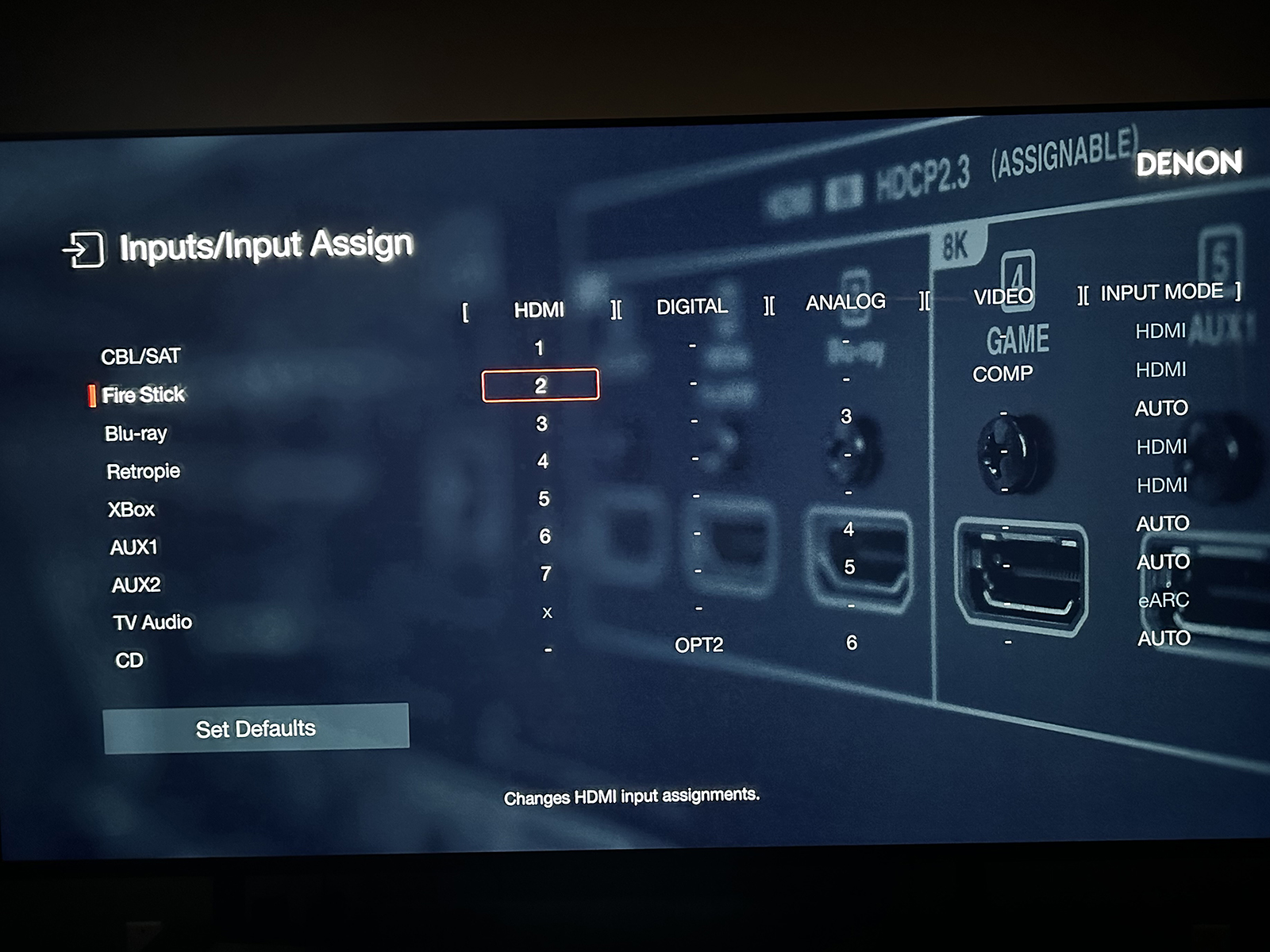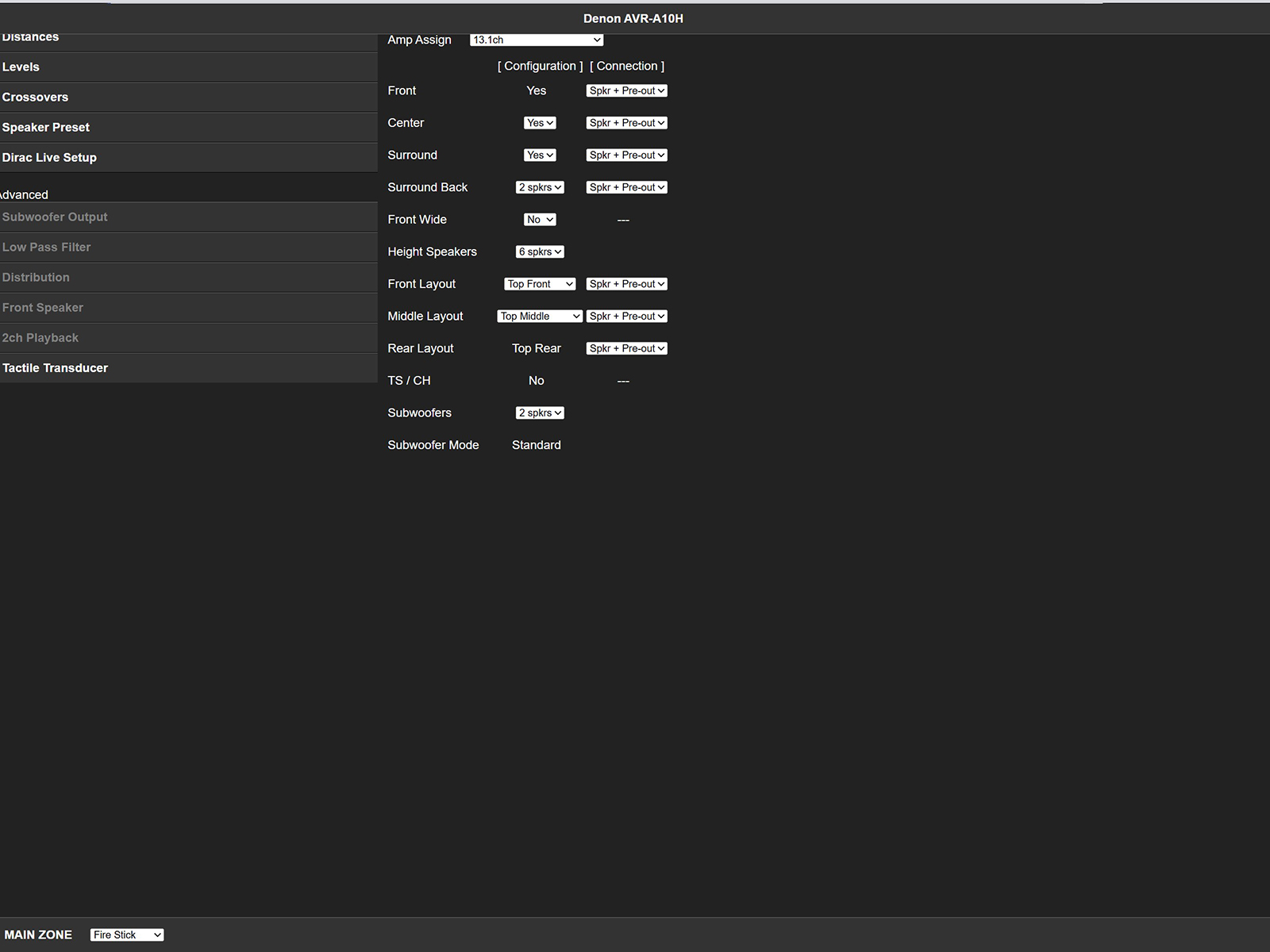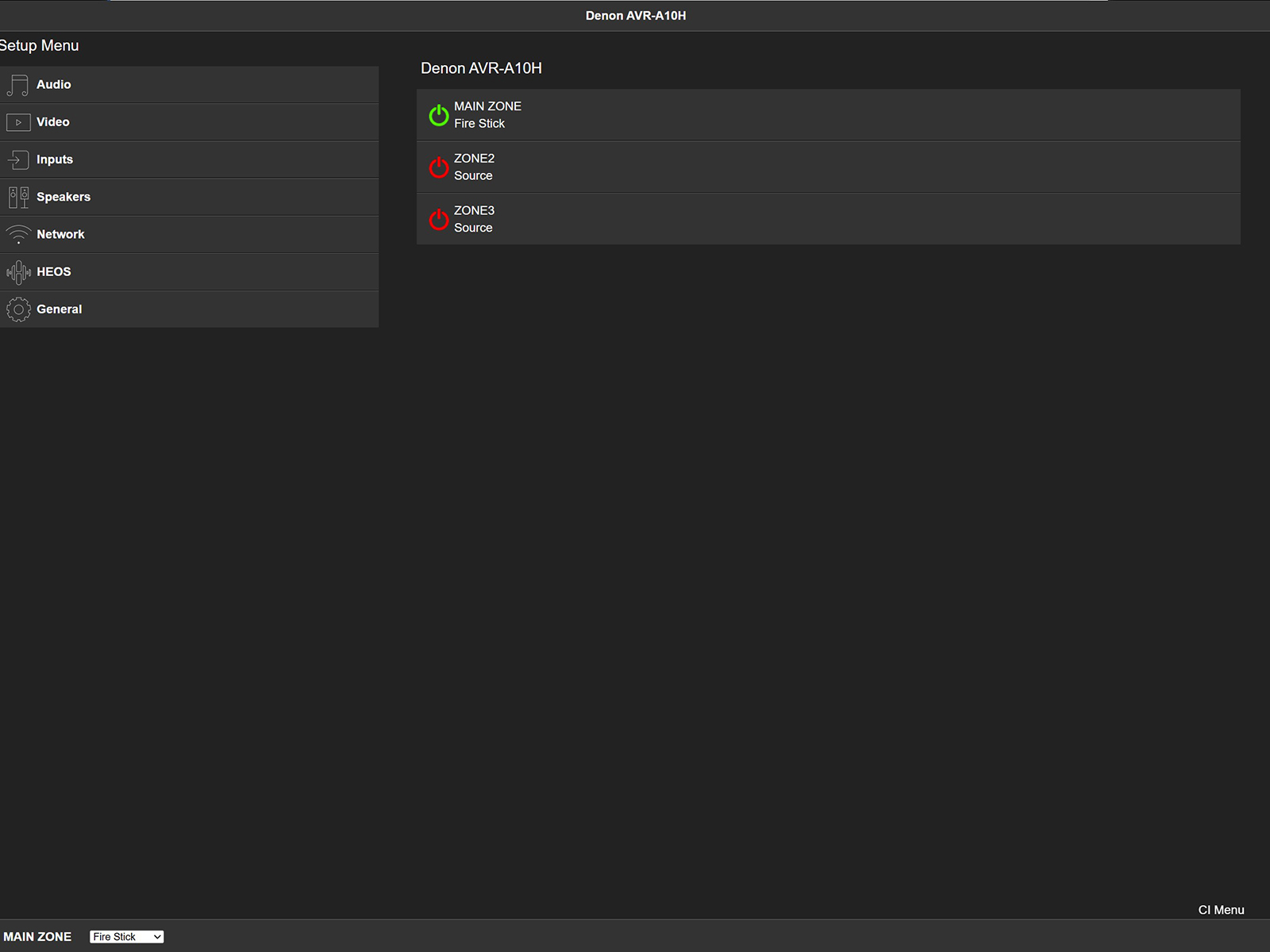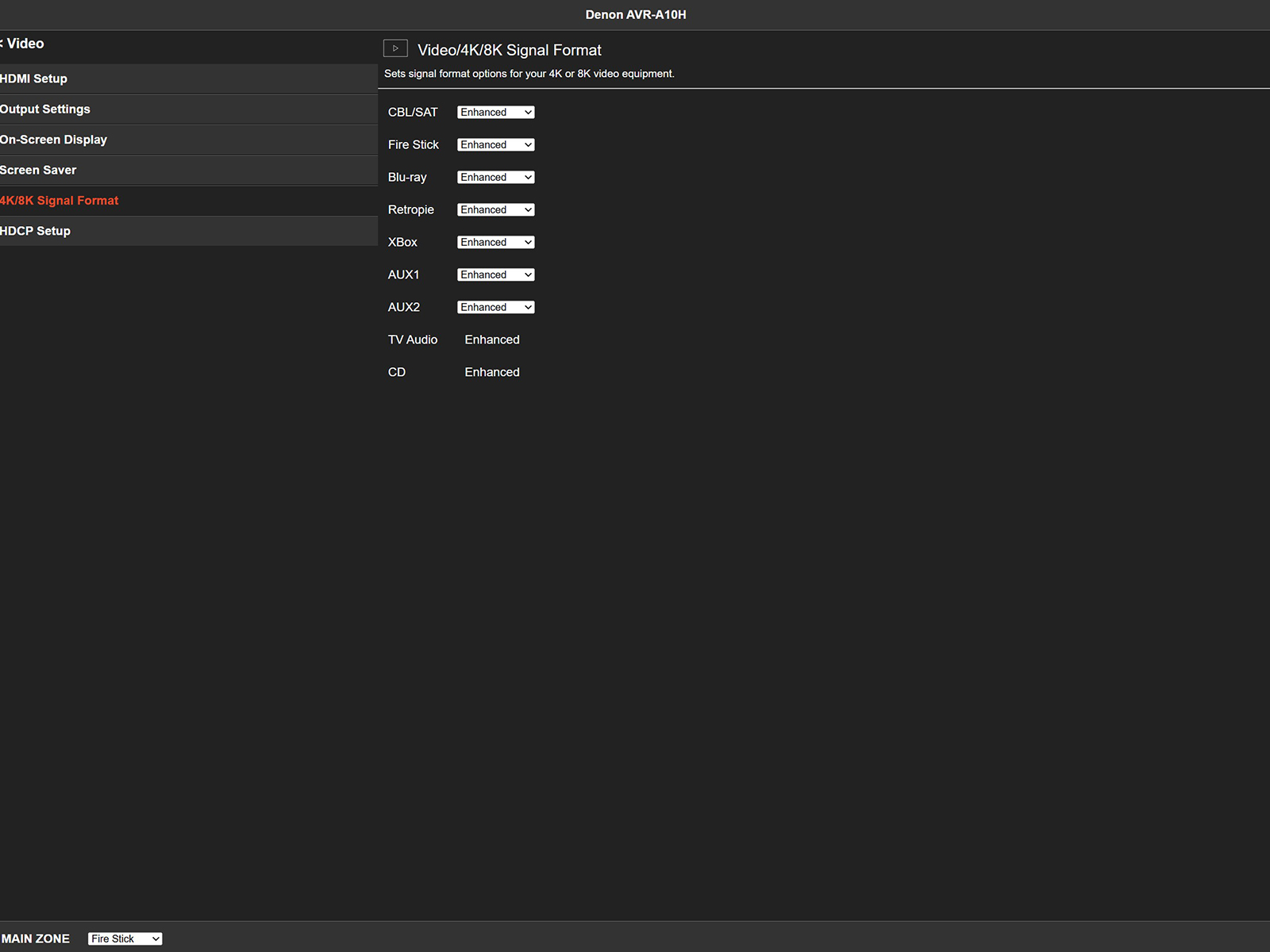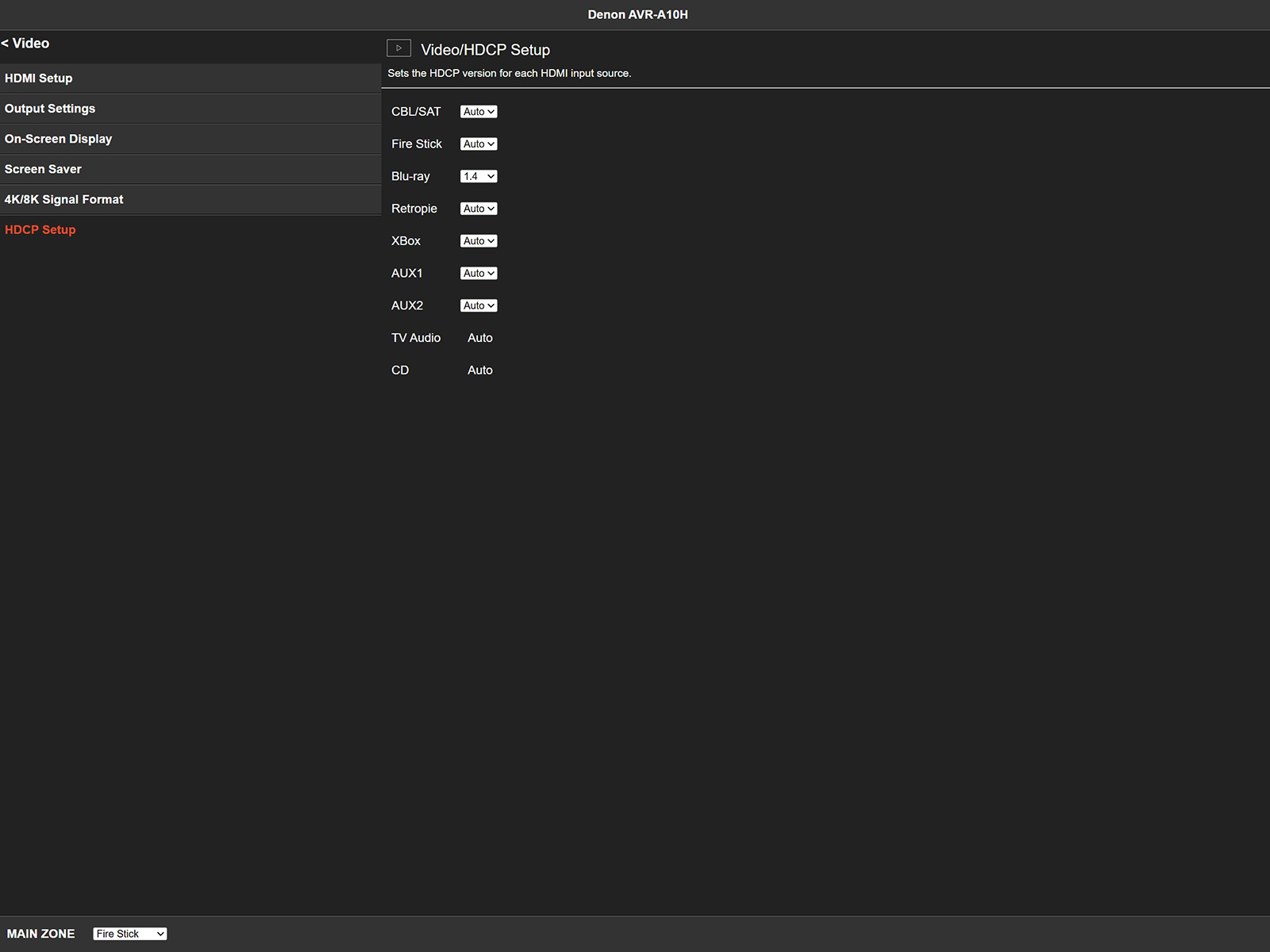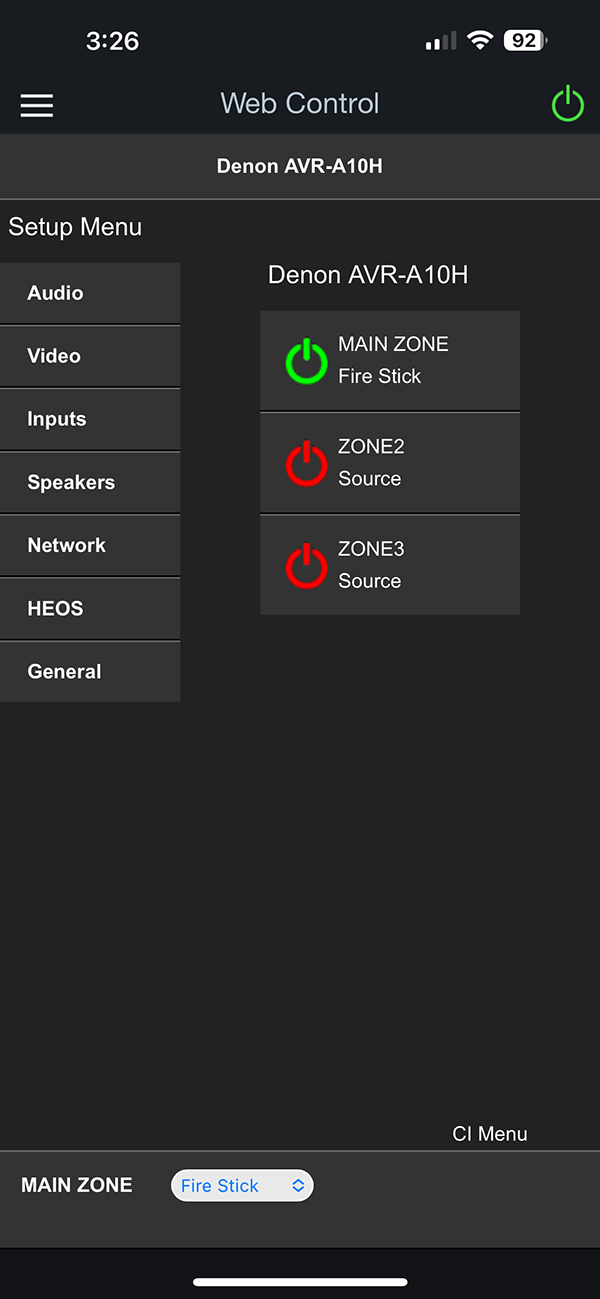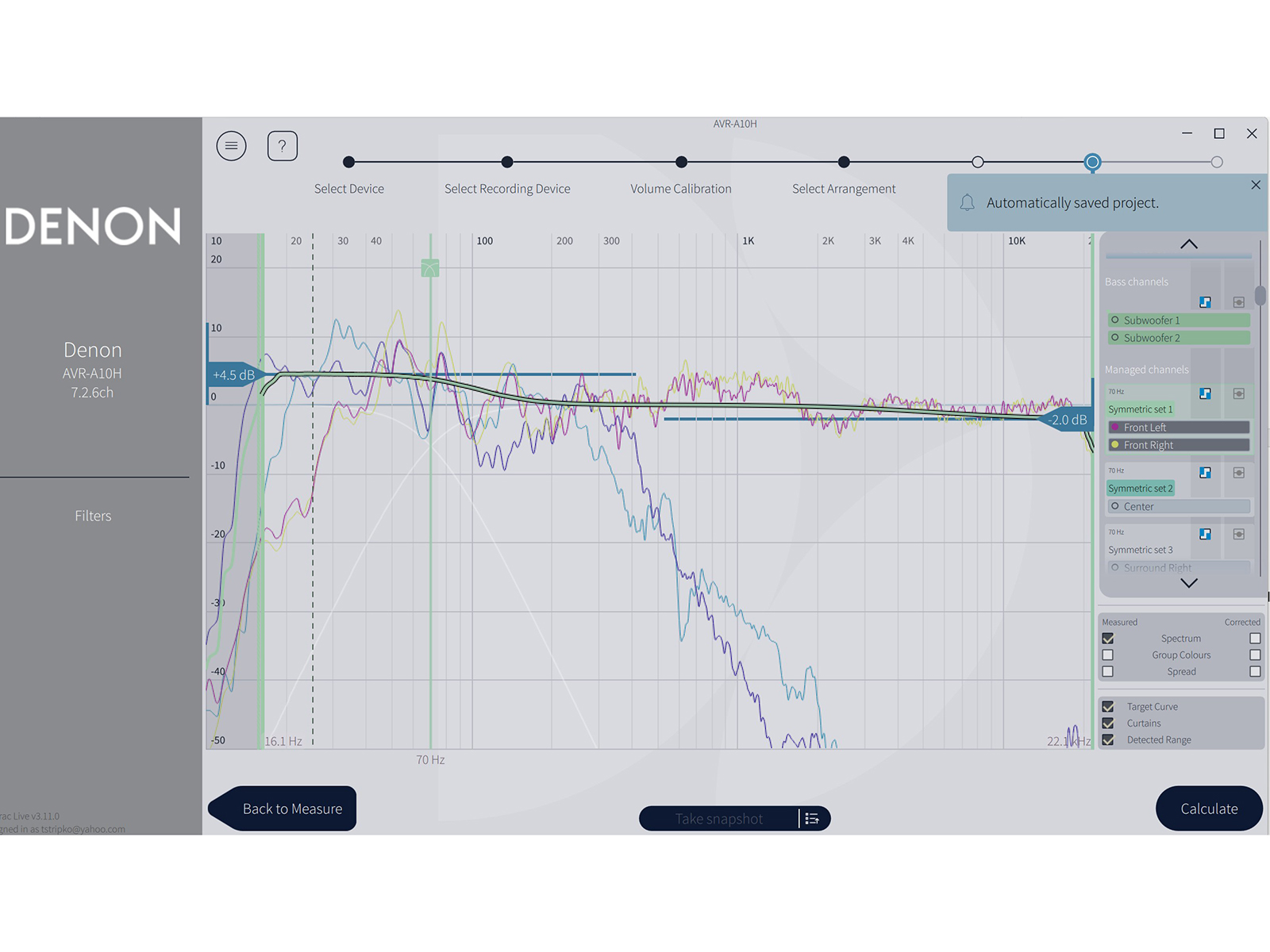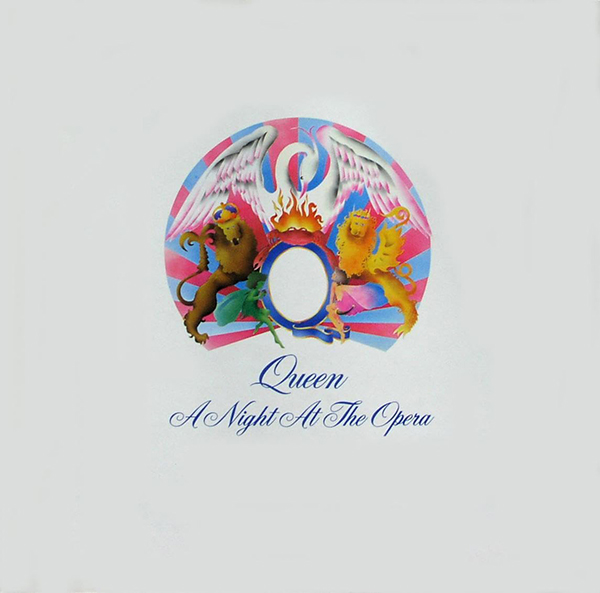Despite losing two channels of processing and amplification to its bigger brother, the AVR-A10H could easily be considered a flagship receiver for those with slightly smaller systems.
Equipped with nearly every feature you could ask for, the Denon AVR-A10H delivers 13 channels of serious power and four independent subwoofer outputs. With stellar sound quality, solid construction, broad connectivity, reliable operation, and support for both Audyssey MultEQ XT32 and Dirac Live room correction, the AVR-A10H is the “mini-flagship” in Denon’s lineup.
Denon AVR-A10H AV Receiver
- 13 channels of processing and built-in amplification
- Plenty of amp power for most speakers
- Four independent subwoofer outputs
- Choice of either Audyssey MultEQ XT32 or Dirac Live (including Bass Control) room correction
- Three-zone control
- Plenty of HDMI 2.1 inputs
- Tons of connectivity options
When it comes to A/V receivers, Denon is one of the biggest names in the business. They have manufactured receivers since 1985 and have remained at the forefront of receiver technology ever since. Denon has a reputation for delivering products with a robust feature set at very competitive prices. Personally, I have found this to be true and have two Denon receivers in my home today: a circa-2002 AVR-3802 that I use for 2-channel sound in my basement and a 2015 AVR-7200WA that has reliably powered my family room theater system for almost 10 years now. I haven’t had a “mainstream” A/V receiver in my system for review since the Onkyo TX-SR607 way back in 2009, so I was absolutely game when the chance to review Denon’s “next to flagship” model, the AVR-A10H, presented itself. Since the AVR-A10H can process and amplify up to 13.4 channels simultaneously, I figured I’d give this 52-pound beast of a receiver a real workout by installing it in my reference 7.2.6 Atmos media room system.
Power Amplifier:
Number of powered channels:
13 @ 150W
Power Output:
2 x 150W @8 ohms, 20Hz-20kHz, 0.05% distortion, 2 x 190W @6 ohms. Denon 70% rating (105W minimum) for 5 channels. No rating for all channels driven
Amplifier Topology:
Class A/B
DACS:
9 x 2-channel ESS ES9018K2M
Multichannel Surround Technologies:
Dolby:
Dolby Atmos, Dolby TrueHD, Dolby Digital, Dolby Digital Plus, Dolby Surround (music, movie, night), Dolby Atmos Height Virtualizer
DTS:
DTS-X, DTS-X Pro, DTS, DTS ES, DTS-HD Master Audio, DTS HD High-Res Audio, DTS Neural X, DTS: Virtual X
Others:
AURO-3D, MPEG-H, 360 Reality Audio, IMAX Enhanced, multichannel/2ch PCM/LPCM
Max Number of Processing Channels:
13.4 in either a 9.4.4 or 7.4.6 array
Inputs/Outputs:
HDMI In/Out:
7/3
Analog In:
6 x RCA
Phono In:
1 x RCA (Moving Magnet)
Digital In Optical/Coaxial:
2/2 up to 192kHz/24-bit
USB Inputs:
2 x USB-A up to 192kHz/24-bit
Multichannel Preamp Out:
15.4 (but only 13.4 can be processed)
Subwoofer Out:
4 (independent)
Number of Speaker Terminal Pairs:
15
Other Inputs/Outputs:
1 x RS232C, 1 x 3.5mm IR in/out, 3 x 3.5mm 12V Trigger Out, 2 x composite video in, 1 x component video in, 2 x RCA zone out, 1 x AM antenna, 1 x FM antenna
HDMI:
Total Inputs/No. Supporting 8k:
7/7
HDCP 2.2/2.3 Support:
Yes/Yes
HDMI Outputs:
3 (Zone 2 limited to 4k)
Max Resolution @ Framerate:
8k @60Hz, 4K @120Hz
Audio Return Channel:
ARC, eARC (HDMI main output)
Video Dynamic Range:
HDR, HDR 10+, Dolby Vision
Other HDMI Features:
HDMI Pass-Through, CEC, On-Screen Display (OSD)
Other Features:
Acoustic Room Correction:
Audyssey XT32, Dirac Live (optional), Dirac Live with Bass Control (optional)
Music File Support:
WAV, LPCM, AIFF, FLAC, ALAC, MP3, MP4 (AAC), WMA, OGG, DSD (up to PCM 24/192kHz and DSD 128/5.6MHz)
Streaming Features:
HEOS, WiFi, AirPlay, Bluetooth, Roon Tested (Roon Ready Certification Pending)
Networking Inputs:
1 x RJ-45 10/100 Ethernet, Wi-Fi
Physical Specifications:
Available Colors:
Black, Silver
Dimensions (W x D x H):
17.1 x 19 x 7.7”
Weight:
52 lbs.
Warranty:
3 years
MSRP:
$4,699
Website:
Company:
SECRETS Tags:
denon, avr-a10h, av receiver, surround receiver, surround sound, home theater, dolby atmos, dts:x, audyssey, dirac live
Secrets Sponsor
The Denon AVR-A10H sports a pretty minimalist look. The front façade is a simple black rectangle with a wide, 2-row display in the middle. A round source select knob sits to the left of the display with a larger round volume knob to the right of the display. Beneath the main display is a flip-down panel that conceals some additional buttons as well as the USB input, the headphone output, and the Audyssey setup mic input. While the main chassis face is made of thin brushed aluminum, the door panel appears to be a solid chunk of aluminum and feels incredibly solid. It opens and closes with a very smooth motion that just screams “quality.” The top and side panels have lots of ventilation cuts, which are key to managing heat in a receiver with this many channels of Class A/B amplification.
I can describe the back panel of the AVR-A10H in one word – packed. The Denon has every single connection type I could think of: RJ-45 network, 7 HDMI inputs (all HDMI 2.1/HDCP 2.3 capable), 3 HDMI outputs (including a 4k-limited second zone), optical and coaxial digital inputs, 6 pairs of analog inputs, analog outputs for zones 2 and 3, 15 channels worth of analog pre-amp outputs, and 4 independent analog subwoofer outputs. Denon has even included 2 composite video inputs, a single component video input, and a moving magnet phono input with a grounding terminal for vinyl lovers. For control, there are 3 12V trigger outputs, IR in/out, and an RS-232C jack. There are two Wi-Fi antenna jacks for those who prefer wireless network connections as well. About the only jacks not on the back panel are XLR inputs/outputs, but other than possibly a single pair of XLR inputs, I don’t see the need for them on an A/V receiver. Rounding out the back panel are 15 pairs of speaker binding posts. The AVR-A10H can only process and power 13 channels at a time, but you can configure the unit to use the additional speakers in a separate configuration, like one that uses front wides in place of a third set of height speakers.
The AVR-A10H is built at Denon’s premier factory in Shirakawa, Japan, and includes a host of top- notch components. Starting with a three-layer chassis to protect against vibration and interference, Denon adds nine 2-channel ESS ES9018K2M DACS, and each amplifier is built on its own PCB. The premium gold-plated speaker terminals on the back panel felt very solid and looked great. Denon also includes a nice remote control, which is backlit and includes direct-access buttons for all sources and zones as well as the sound modes. There are also four “Quick Select” buttons that allow a user to instantly recall combinations of input source, volume level, and sound mode. These shortcuts even work for each zone, which is a nice touch.
As I have come to expect from Denon, setting up the AVR-A10H in my media room system was a breeze. The hardest part was getting the 52-pound unit out of its sturdy box and loading it into my equipment rack. With the AVR-A10H in place of my reference Trinnov Altitude32 processor, I used 13 banana-plugged Kimber4VS and KWIK-12 speaker wires to connect my seven Sonus faber Olympica bed layer speakers and six Sonus faber Palladio height channels. Small nit to pick: while the binding posts looked and felt well-made, they were a bit looser than I prefer, with only a gentle tug required to pull my banana connectors out. RCA cables were used to connect my Hsu Research subwoofers to the “Sub1” and “Sub2” outputs. While the Denon has Wi-Fi networking, I plugged a single RJ-45 cable in to join the AVR-A10H to my network. I then used HDMI cables to connect my Comcast Xfinity cable box, Oppo UDP-205 4K Blu-ray player, Amazon FireStick 4K Max, and RetroPie (Raspberry Pi-based) gaming box to the Denon. As I wanted to test out the Denon’s HDMI eARC capabilities, I kept my Xbox Series X console connected directly to an HDMI 2.1 port on my Sony 83” A90J OLED display and then connected a single HDMI cable between the Sony OLED and the Denon’s “TV1” HDMI port. Kudos to Denon for retaining seven HDMI inputs on the AVR-A10H; users with multiple streaming devices or gaming systems should have no problem connecting all of their devices at once. Since the Denon has an IR-in port, I was able to connect the AVR-A10H directly to my URC MRX-2 remote control hub for control via my URC MX-990 universal remote. The Denon also supports IP control, which can be done via Denon’s AVR Remote app (iOS or Android), from any web browser (you just need to know the IP address), or via control systems that have the appropriate Denon IP driver.
With all my cabling and sources connected, I opened up the Denon’s on-screen menus to check out the setup options. Denon has continued to improve their menu system, and everything is logically organized. They have also stepped up the resolution of the on-screen menu, so it looks much better now than the old “SD” menus. However, as good as the on-screen menu system is, Denon’s web control is even better. Just type the receiver’s IP address into any web browser and you’ll get the full set of configuration menus on your PC, tablet, or smartphone. Having access to a keyboard and mouse makes it far faster to do things like rename inputs and change settings. In less than five minutes, I had everything set up exactly as I wanted, without needing to read the instruction manual. You can also access the web control from within the Denon control app (iOS or Android). While in web control, I also set up my HEOS account, as I was looking forward to trying out Denon’s streaming app for the first time. The AVR-A10H is “Roon Tested,” so with the Denon now on my network, I went to my Roon server and added the Denon as an additional destination. While the “Roon Tested” status means that I would be forced to use lossy Apple Air Play 2 for Roon playback, Denon is currently in the process of getting the AVR-A10H “Roon Ready,” (ETA first half of 2025) which will allow for lossless audio playback directly over the network as well as better control options.
At last, it was time to get the speaker distances and levels set. Audyssey MultEQ XT32 is included with the Denon and uses the included Audyssey microphone to perform a full system calibration. I ran a regular MultEQ calibration with the included microphone and was more than satisfied with the result. The calibration was easy, and levels and distances were spot on. The overall sound was also pretty good, but not quite as musical as I prefer. I blame this on the default flat response curve, midrange compensation dip, and the inability to adjust the target curve. You can also purchase a license for Audyssey MultEQ-X ($199.99), which gives you additional options within Audyssey. MultEQ-X can be paired with a calibrated ACM1-X Audyssey microphone ($79.99 via Amazon) to give a more accurate calibration than the included mic. From prior experience, MultEQ-X can lead to a better result if you are willing to make the purchase and spend some time tweaking. It also gives you more customization options, particularly with your target curves. However, most people who buy a $4,699 receiver are looking for the best performance possible, so I wanted to take things a bit further. The AVR-A10H also allows for Dirac Live calibration, up to the Bass Control level. Currently, a “Full Bandwidth” Dirac Live license is $349, with the “Bass Control” license being an additional $299. Dirac offers a bundled license for $599, and I would certainly recommend taking the package. Dirac Live Active Room Treatment is not currently available for the AVR-A10H, but may be offered in the future. As I happen to have a Dirac Live Bass Control license, I connected my Cross Spectrum Labs-calibrated UMIK-2 microphone to my Windows 11 laptop and kicked off a Dirac Live session. I’ve had some issues getting a good calibration out of Dirac Live in the past, but Denon’s integration with the Dirac Live app was seamless. There were no issues getting the proper volume or mic levels, and my final calibration matched the non-calibrated volume level closely. I used 14 measurement positions for my calibration, which took a good amount of time, considering that there were 15 speakers being measured per mic position. The results were well worth it, though. After applying a bit of a “Harman curve” to the overall frequency response, I was left with a more musical, natural response that more closely followed the native response of my Sonus faber speakers and gave a bit more “oomph” in the bass as well as a smoother treble roll off. Bass integration was noticeably better with Bass Control engaged, with the overall handoff between my speakers and the subs being audibly superior to what I heard with the base Audyssey calibration. If you’ve got more than one subwoofer, I would consider the Bass Control license mandatory. Considering the AVR-A10H’s price point and its performance potential, I would really like to see either a MultEQ-X license or the base Dirac Live license included with your purchase.
With the AVR-A10H now fully tweaked, it was time to get down to assessing its sound quality. I started off with some Melody Gardot via my Roon server, but quickly became dissatisfied with how thin things sounded via the compressed AirPlay 2 stream. Not wanting to hamstring the Denon unfairly, I switched to the HEOS app on my iPhone and connected it to my NAS via DLNA to access my full collection of high-resolution music files. Via uncompressed HEOS, the 96 kHz/24-bit FLAC file of “What of Your Eyes” from Gardot’s “Entrée Eux Deux” came alive. Instead of dull and lifeless, the sound was now rich and enveloping. Gardot’s fabulous voice now possessed the expected fullness and body inherent in this fantastic recording. The piano notes rang out beautifully and displayed the appropriate timbre. Bass notes were deep and clean. The soundstage opened up significantly in depth as well as width. Overall, this was simply fantastic sound. HEOS conveniently allows you to control the sound mode of the Denon right from the “now playing” screen, so I switched from “Stereo” playback (which uses the Dirac correction and bass management) to “Pure Direct,” which disables all EQ, processing, and bass management. This further improved the overall sound by removing the final layer of haze imparted by the Dirac processing and let my Sonus faber Olympica IIIs sing out in their own voice. While it wasn’t a tremendous difference, “Pure Direct” really showed just how transparent and refined the Denon could sound when freed from digital processing. The AVR-A10H has an inherent sense of purity and clarity to its sound that is incredibly enticing. This clarity allowed me to hear very subtle sonic details, but I never felt that the sound was bright or harsh. The AVR-A10H’s overall sound was tuned by “Denon Sound Master” Shinichi Yamauchi, and I have to say he did a tremendous job.
While I could talk about the Denon’s excellent 2-channel musical capabilities all day long, the AVR-A10H is a multichannel unit, so I wanted to get the other 13 speakers in my setup firing. Amazon Music has been adding tons of music in Dolby Atmos, so I loaded up my playlist of Atmos favorites, turned the Dirac Live correction back on, and cut loose. Billie Eilish’s “Oxytocin” in Atmos sounded pretty awesome. The contrast between her soft vocals and the deep, pounding bass line was really well displayed through the Denon, adding a really ominous character to this track. Eilish puts a lot of small inflections into her vocals, and the exceptional clarity of the Denon’s sound allowed me to hear these tiny little details. There are some cool synth lines running through the surrounds and heights here, which came across really nicely. The overall sound field thrown by the Denon was big, open, and very cohesive, with a nearly seamless movement of sound from speaker to speaker. The few moments where Eilish lets her voice loose in more of a scream showed off some nice dynamics. The new Atmos remix of Queen’s “Bohemian Rhapsody” was a blast through the AVR-A10H as well. With its multiple layers of sound, “Bohemian Rhapsody” is a natural choice for an immersive mix. Freddie Mercury’s vocals were strongly fixed in the center channel, and the AVR-A10H’s clarity allowed them to cut through the mix nicely. Brian May’s searing guitar work was rooted solidly in the front channels and sang out with his very distinct tone. The vocal harmonies (Galileo!) pan across the surround and height fields, which really bring you into the song. Bass isn’t too deep on this mix, but the drums were very crisp and tight.
I finished up my formal listening by playing back one of my all-time favorite surround albums, Talking Heads “Speaking in Tongues” (5.1 MLP DVD-Audio). After engaging AURO-3D processing (bonus points to Denon for including it) to get the rear surrounds and height channels engaged, I kicked off the alternate take of “Burning Down the House” and started pushing up the volume. At sane listening levels, everything sounded amazing. While this is a superbly engineered disc that sounds great on pretty much any piece of gear, I was still amazed at how good it sounded through the Denon. Once again, the AVR-A10H’s wonderful sense of clarity and neutrality really shone through. This track has discrete effects scattered throughout the sound field, and I was able to hear them all. The movement of sound was excellent from speaker to speaker, and really created a huge bubble of sound. AURO-3D processing extended that bubble into the vertical space above me. David Byrne’s vocals sounded perfect, and the powerful bass kicked hard. Once again, Dirac Live Bass Control really proved its worth. However, as I crested the 100dB mark with all 13 channels running hard, the amps in the AVR-A10H started to show signs of stress. The sound became noticeably brighter and harsher in the treble, and the sense of clarity diminished greatly. Shutting off AURO-3D and driving just five channels allowed me to get up to a similarly high volume level without any of the negative side effects. Please don’t think that I am picking on the AVR-A10H here as this is the only chink I could find in the AVR-A10H’s armor. While the Denon is rated at 150W, this is with 2 channels driven. The output with all 13 channels running simultaneously is significantly lower as you run into the limits of the power supply. My Sonus faber speakers are all 4-ohm designs with efficiency ratings around 88 dB for the mains and 90dB for the heights. This is not the easiest load for a receiver to drive, and that is why my reference setup uses two separate 8-channel amps on dedicated 20-amp power lines. If your speakers are more efficient or if you are driving less than 13 of them, I doubt that you will ever run into the Denon’s output limits.
After the excellent performance of the AVR-A10H with multichannel music sources, film soundtracks were a piece of cake. “Transformers: One” (UHD Blu-ray) is an interesting animated origin story of Optimus Prime and Megatron and is probably my second favorite Transformers film after “Bumblebee.” While D-16’s path towards becoming Megatron was a bit weak (a la Anakin Skywalker’s fall to Darth Vader), the same cannot be said of the lossless Dolby TrueHD Atmos soundtrack. This is a big- sounding film, with lots of crashes, explosions, and engine noises. There is a lot of bass in this film, and it had my media room shaking at multiple points. Bass clarity and integration were excellent, once again aided by Dirac’s Bass Control. While the louder action scenes were great, some of the quieter moments really drew me in too. The Denon’s strong resolution of detail made the intro scene with Orion Pax searching through a storage area sound incredibly realistic. There are lots of little sonic queues scattered throughout this scene that made me feel like I was inside the room with Orion. Dialogue was incredibly clear and always remained intelligible, even when there was a lot of other action going on in the sound field.
While we can debate the merits of stretching out the already long Broadway version of Wicked (about 2.5 hours) into two separate, equally long movies, there is no denying that “Wicked” (Atmos, Dolby Digital+) sounded great. Despite the compressed Dolby Digital+ format, the AVR-A10H made the film sound rich and big. This is a very active surround mix, but speech always remained clear and intelligible. The height channels were used sparingly in this mix, but they did add nice ambiance during certain scenes. Bass was not butt-shakingly deep, but what was present was clean and powerful through the Denon. The musical numbers are the real stars of this movie, and the Denon did a wonderful job showing off Cynthia Erivo and Ariana Grande’s tremendous vocals. The tone and timbre of their voices sounded very natural and filled the front sound stage. I was fortunate to have seen Wicked on Broadway with its original cast of Idina Menzel and Kristin Chenoweth, and Erivo and Grande certainly did them proud.
My seven-year-old son has been in a vehicular mayhem and destruction phase of late, so I treated him to a viewing of “Mad Max: Fury Road” (UHD, Atmos Dolby TrueHD). I hadn’t watched this disc in a while and had forgotten just how awesome this Atmos soundtrack is. Reference-level is an understatement, and it was a blast through the AVR-A10H. From the opening scene with the roar of high- revving V-8s (may they live forever) and screaming superchargers, this movie never lets its foot off the gas (or should I say guzzoline?). Each of the vehicular chase scenes was a real treat, with the explosions and gunshots generating tons of deep, impactful bass. Sound effects like the swirling sandstorms come at you from all sides, and the addition of the Atmos height channels just further pulls you into the action. For a gearhead like me, the engine sounds were a true work of art, with each Frankenstein vehicle having its own unique tone that sounded completely accurate. While not as loud, I loved Max’s flashbacks, where the voice of the little girl fills up all of the speaker channels (and Max’s head), making for a pretty creepy experience. The Denon’s exceptional clarity even allowed me to understand Tom Hardy’s trademark mumbly dialogue, which was a rare treat. At my son’s urging, I played this pretty loud, and the AVR-A10H had no trouble keeping up with the huge dynamics of the soundtrack. This is now my son’s favorite movie.
Secrets Sponsor
The Denon AVR-A10H A/V Receiver delivers flagship performance and features at a below-flagship price. It has everything a home theater enthusiast could possibly want.
- Incredibly clean, musical sound
- Excellent resolution of detail
- Support for every major surround sound codec (including AURO-3D)
- Well-built
- Easy setup and great on-screen menu system
- HEOS works well to integrate multiple streaming sources
- Lots of flexibility with speaker/zone setup
- Dirac Live or Audyssey MultEQ-X room correction are extra cost options
- No Dirac Live Active Room Treatment (ART) yet
- Roon Ready certification is still pending
- Runs fairly hot
- HEOS playback limited to 192kHz/24-bit files and DSD 5.6Mhz, two-channel only
- Binding posts could be a bit tighter
- Design is fairly bland
Considering the $4,699 MSRP and Denon’s track record of delivering a lot of performance for the money, I had VERY high expectations for the AVR-A10H. I am pleased to report that not only did the Denon meet those expectations, but it greatly exceeded them. In the three months that I had the AVR-A10H in my system, I listened to many hours of music and watched countless movies and TV shows. The Denon made every one of those sessions completely enjoyable with its beautifully detailed sound profile and excellent bass integration. I was even more impressed with how trouble-free the AVR-A10H operated. Everything just plain worked, which is a borderline miracle in today’s networked and HDMI’d world. The AVR-A10H solidly takes the place as the overall best performing A/V receiver I’ve had the pleasure of using. If you are looking for reliable, cutting-edge performance but don’t want to jump into the added cost and complexity of separates, Denon has built the perfect solution in the AVR-A10H.
While technically Denon’s penultimate model, $4,699, is still what I would consider flagship pricing for an A/V receiver. However, the AVR-A10H really has just about everything a home theater buff could want; 13 channels of processing, 13 channels of high-powered amplification, support for four independent subwoofers, three-zone support, a truly comprehensive set of inputs, great build quality, two choices in room correction, decoding for every key surround sound codec, and a great built-in streaming platform in HEOS. Add in the slick on-screen menu system, easy setup, fantastic web/IP control, and tons of setup flexibility, and the Denon’s price doesn’t seem unreasonable. Most importantly, the AVR-A10H offers flawless operation and sounds fantastic with both music and film sources. To get this level of functionality with better overall performance, you’d need to spend a lot more money on either a boutique product or by jumping into the world of separates. Well done, Denon!
I enjoyed my time with the AVR-A10H so much that I bought the review sample to replace my aging Denon X7200WA.


